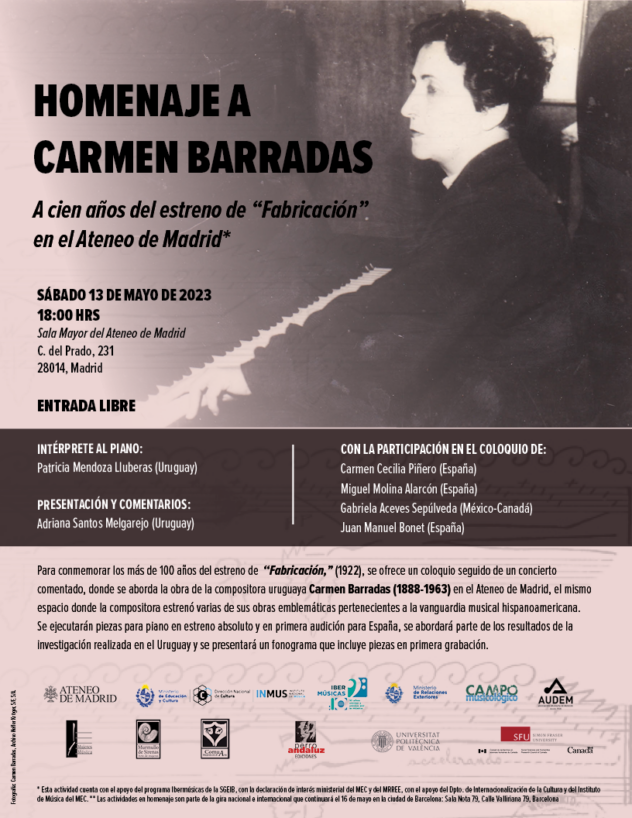Homenaje a Carmen Barradas, Ateneo de Madrid, May 13th @ 6:00 pm
So excited and honoured to be part of this symposium/concert in commemoration of the 100-year anniversary of Carmen Barrada’s premier of “Fabricación” at the Ateneo de Madrid along with Carmen Cecilia Piñero Gil, Juan Manuel Bonet, Miguel Molina Alarcón, Adriana Santos Melgarejo and Patricia Lluberas
If you are in Madrid or Barcelona, please join us:
Saturday, May 13 at 6:00 pm
Ateneo de Madrid, Madrid.
Tuesday, May 16, 7:00 pm
Sala Nota 79, Barcelona.
“In 1922 the Uruguayan composer Carmen Barradas (Montevideo 1988-1963) premiered her three pieces for piano, “Aserradero, Fundición y Fabricación (Sawmill, Foundry and Fabrication),” at the Ateneo de Madrid. In this recital, Carmen rolled out her preliminary experiments with a polytonal system and graphic notations. During the recital, she also included technical compositional elements that were the forerunners of John Cage’s prepared piano. In some of her works, after executing wide chromatic arpeggios, she used clusters and a sustaining pedal resulting in a superposition of harmonics. She also inserted small objects into the piano harp that modified the instrument’s timbre. Spanish critics of the time enthusiastically praised her experiments and considered her work a true expression of the art of that time. However, on her return to Uruguay in 1926, her work was not as warmly received: Barradas’ compositions were misunderstood within the romantic and nationalist musical context that prevailed in Uruguay at that time. Carmen’s graphic notations are also one of the first examples of avant-garde notation.
However, Carmen Barradas is known mainly as the sister of the painter Rafael Barradas, who, in turn, is recognized as the creator of Vibrationism, an avant-garde pictorial style. Between 1915 and 1926, Carmen and her brother Rafael resided in Spain where they developed a collaborative working relationship that led Carmen to develop “Plástica Musical,” a unique approach to graphic notation that incorporated some of Rafael’s pictorial forms. During this time, the Barradas siblings were also part of a large gathering of artists and intellectuals, which included Federico García Lorca, Salvador Dalí, Joaquín Torres García, Margarita Xirgu and Filippo Tommaso Marinetti, among many others. While in Europe Carmen’s compositions were appreciated for their adherence to the futuristic aesthetic of the time, in Latin America her work received little attention and was overshadowed by Rafael’s career.”
Excerpt from: Aceves Sepúlveda, Gabriela and Santos Melgarejo, Adriana. (2022) “Carmen Barrada’s Plastica Musical: Crossovers between notation and painting, (1888-1963)” In Open Scriptures: Notation in Contemporary Art in Europe and the Americas, Susana González Aktories y Susanne Klengel (eds.), Iberoamericana/ Vervuert, Madrid/Frankfurt), 147-162.


